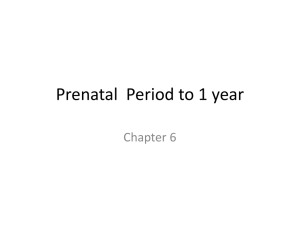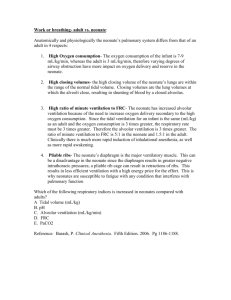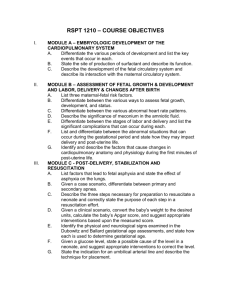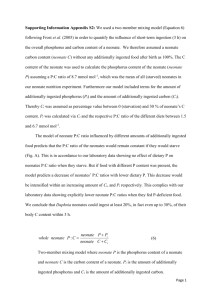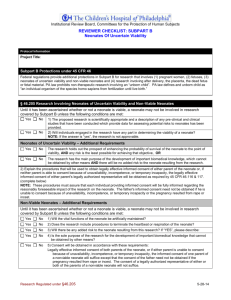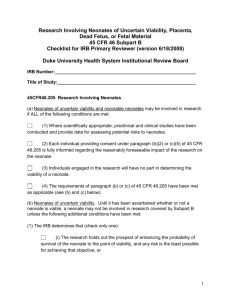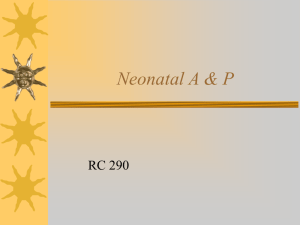Prenatal Period to 1 year
advertisement
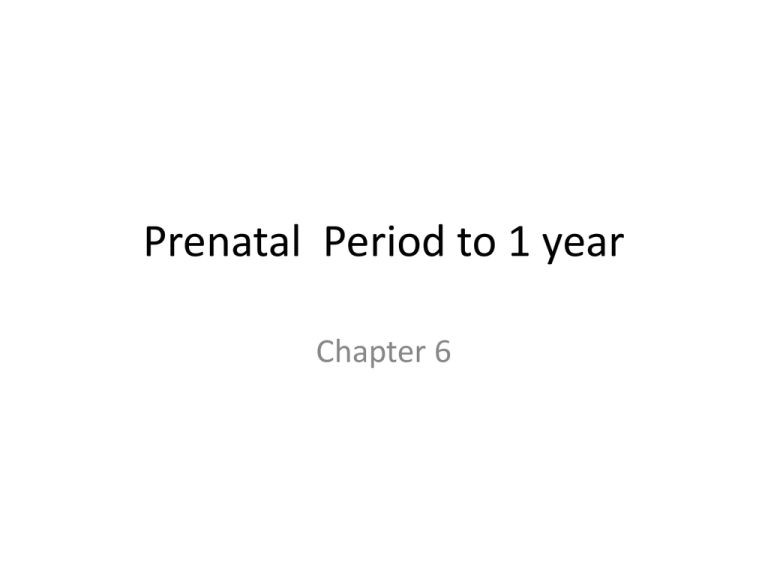
Prenatal Period to 1 year Chapter 6 What are the two main factors that influence growth and development? A. B. C. D. Stress and Family Environment and Stress Environment and Heredity Heredity and Gender Heredity: Zygote formation • Sperm & ovum – 23 chromosomes – Zygote • Gender – X & Y Chromosomes • Ovum – Always X • Sperm – X or Y Dominant & Recessive Genes Dominant • Capable of expressing traits over other genes Recessive • Traits only appear if they exist in pairs Recessive disorders • >700 recessive gene diseases – Sickle-cell disease – Tay-Sachs disease – Hemophilia Environment • “From the moment life begins, the environment begins to exercise its influence on the newly formed entity.” For you personally, when does life begin? A. B. C. D. E. Conception Implantation When there is a heart beat When the fetus is viable if it was born When the baby is born Healthy Pregnancy • Rest • Exercise – Continue What is the best form of exercise for a pregnant women? A. B. C. D. E. Bicycling Walking Swimming Jogging Kick-boxing Teratogens • Tobacco – Low birth rates – Growth restrictions Teratogens • Alcohol – *1st trimester – Fetal Alcohol Syndrome (FAS) – Miscarriages – Growth restriction – CNS damage Teratogens • Bacteria, protozoan, viruses – Rubella • Toxoplasmosis – Parasite – Eat well-cooked meat Ova to Fetus • Ovaries – Ova (pl) – Ovum (sing) • • • • • • • Ovulation Sperm Conception/ Fertilization Zygote Implantation Embryo Fetus What is the estimated length of human pregnancy? A. B. C. D. E. 28 weeks 38 weeks 40 weeks 42 weeks 48 weeks Stages of Labor & Delivery • Stage 1 – Dilation • Dilation • Effacement • Stage 2 – Expulsion • After-brith – placenta Fetal membranes • • • • Amniotic sac Amniotic fluid Placenta Umbilical cord – 2 arteries – 1 vein Neonate • 1st breath • Apgar score – 1 minute – 5 minutes APGAR • • • • • Activity Pulse Grimace Appearance Respiration • activity and muscle tone • pulse • grimace response / reflex irritability") • Appearance / skin coloration • respiration What is the highest score a neonate can get on a Apgar score? A. B. C. D. E. 2 3 10 12 15 Head & Skull • Head ¼ of total body length • Ave circumference – 13-14 inch – 33-35.5 cm – 1 inch > chest Skull • 6 bones – – – – 1 occipital 1 frontal 2 parietal 2 temporal • Separated by cartilage – Sutures • Fontanels – Anterior – Posterior Which fontanel is smaller? A. Anterior B. Posterior When does the posterior fontanel “close” by? A. B. C. D. E. 2 months 4 months 6 months 8 months 12 months or more When does the anterior fontanel usually “close” by? A. B. C. D. E. 6 months 12 months 18 months 2 years 3 years What is the normal lengths of a fullterm neonate? A. B. C. D. E. 12 inches 18 inches 20 inches 24 inches 36 inches How much does a normal infant grow in the first year? A. ½ inch a month B. 1 inch a month C. 1 ½ inch a month D. 2 inch a month E. 2 ½ inch a month Normal Physiological Weigh Loss. How much weight on average does a neonate loss in the first few days of life? A. B. C. D. 5-10 % of birth weight 15-20% of birth weight 25 – 30% of birth weight There is no such thing as normal physiological weight loss in a neonate Skin • Thin & pale • Acrocyanosis • Pigmentation Mongolian Spot • Usually fads by… – Age 4 years • 6 month old Lanugo Vernix Cascosa Milia Physiological Jaundice Genitals • Breasts – Swollen Genitals • Scrotum – Lg & edematous What is the medical term for undescended testicles? • No – this is not multiple choice! Turn to your neighbor and tell them the answer. Cryptorchidism • Undescended testicle/s Cryptorchidism • The testes develop in the abdominal cavity in early fetal life. By 14 to 17 weeks of intrauterine life they migrate to an opening in the body wall known as the inguinal canal. After 28 weeks they pass through the canal and by 35 to 40 weeks reach the scrotum. • Undescended testicles are fairly common in premature infants. They occur in about 3 - 4% of full-term infants. In most cases the testicles descend by the time the child is 9 months old. • Increased risk of – Testicular cancer – Infertility Genital • Urethra • Circumcisions Pseudomenstruation • Blood-tinged vaginal discharge Face • Eyes swollen • Eye treatment – Erythromycin – Silver nitrate When do baby teeth start to come in? A. B. C. D. E. 2 months 4 months 6 months 8 months 12 months Deciduous teeth Which teeth normally erupt first? A. Two lower central incisors B. Two upper central incisors C. Two lower lateral incisors D. Two upper lateral incisors By age 12 months the baby will have 68 teeth Abdomen • Neonate – Lg and flabby • Umbilical cord – – – – Cut Clamped Falls off No tub bathing until… Abdomen • Digestion – Simple carbs • Stomach can hole – Neonate • 1-3 oz – 12 months • 10 – 12 oz Why do you have to “burp” the neonate? • Cardiac sphincter Bowel movement Stool Feces • Meconium – Duration • 1-2 days – Characteristics • Green-black • Tarry • Odorless Bowel movement, Stool or Feces Formula Fed • Pasty yellow or tan • Odor Breastfed • Mustard seed color • Sweet odor Extremities • • • • Short Flexed Finger/sole prints Nurses – ROM – Gluteal folds Gluteal fold assymetry Neurological Characteristics • Newborns – – – – Reflexes Posture Movement Muscle tone Protective reflexes • • • • Blinking Sneezing Swallowing gag Moro / Startle Reflex • Sudden movement Extension & Adduction of extremities • Disappears – 3-4 months Tonic Neck Reflex • Turn head to one side extend arm and leg on that side • Disappears – 5 months Rooting reflex • Stroke cheek enfant turns toward that side and open mouth • Disappears – 4-6 months Sucking Reflex • Sucking movement when anything touches their lips • Diminishes – 6 months Babinski • When sole is stroked hyper-extened & fan out toes & big toe turns up • Disappears – 3 months Palmar grasp • Grasp anything placed in hand • Appears – 6 wks • Disappears – 3 months Spinal Bifida Vision • Newborn – Primative – Nystagmus • 4 months – Binocular vision • 6 months – 20/100 – Depth perception Hearing • 6 wks – Recognize mom and turn to respond • 1 year – ID sounds and source Touch • Birth – Face – Hands and soles • 1 yr – Withdrawal – Recognize source Vital Signs - Newborn • Temp – Initially low – Stabilized • 97.7 -99.5 • Axillary • Pulse – 120 – 160 / min – Apical • BP – 64 / 40 • Resp – 30 – 60 / min – Irregular – apnea Motor Development • Neonate – Purposeless – uncoordinated Gross motor skills • 2 months – Control head • 4 months – Sit with support – Roll belly to back • 6 months – Roll both ways • 8 months – Sits alone • 10 months – Laying to sitting – Creep • 11 months – Pulls self up • 12 months – walks Fine motor skills • Neonate – Grasp reflex • 5 months – Purposeful reaching • 6 months – Hold bottle • 7 months – Hand preference – Pincer grasp • 9 – Cup – Spoon • 12 months – Scribble – Tower – two blocks Psychosocial Development: What theorist are we going to discuss? A. B. C. D. E. Freud Erikson Paiget Kohlberg Maslow What stage of psychosocial development is a neonate? A. Autonomy B. Trust C. Initiative D. Industry E. Identity Parent-child relationship Attachment Engrossment Parent guidance / discipline • 0-6 months – Distraction • 6-12 months – More direct discipline Cognitive development: Who’s theory are we going to be applying? A. Freud B. Erikson C. Paiget D. Kohlberg E. Maslow What stage of cognitive development is an infant? A. Preoperational B. Concrete operational C. Sensorimotor D. Formal operational Moral Development • Neonate – No conscience – !00% ID Communication: What “name” or word to baby’s say first (usually) A. MaMa B. DaDa Communication • Birth – Crying • 8 months – Dada • 2 months • 10 months – Smile – Coo – Mama • 4-6 months – Babbling • 12 months – 4-6 words Nutrition Sleep & Rest Play Safety: Aspiration • Avoid small objects • Age aprop toys Baby harm • • • • Sharp objects Heavy objects Animals Shaken baby syndrome Burns • • • • Check water temps Smoke detectors Handles of pans in Cover electrical outlets Drowning • Bathtub never alone Falls • Mattress lowest position – firm • Infant seat with restraint • Infant seat on the ground • Safe gaits – Slide – Not accordion Poisoning • • • • • Lead paint Plants Safety locks Medicine CO monitor MVA • Read facing car seat • 12 months
